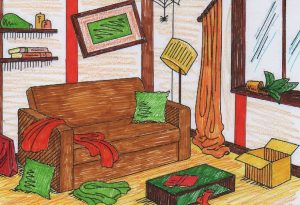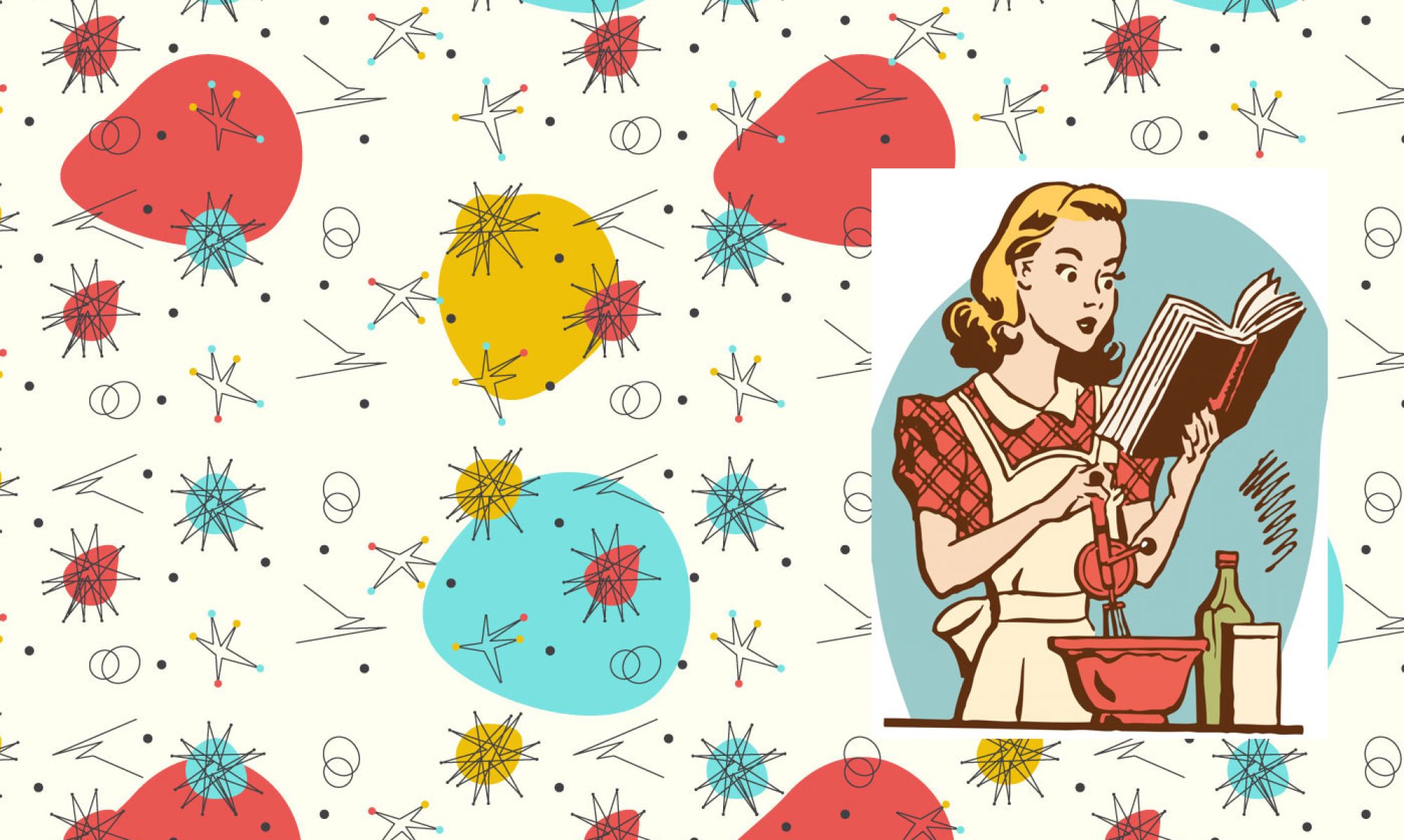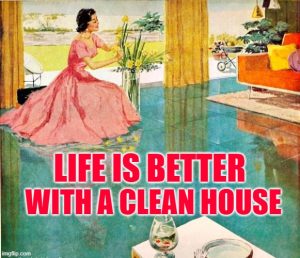 Note: This is a long post because there is so much to say about mid-century cleaning. I didn’t cover more than a fraction of it so I will come back to the topic again soon.
Note: This is a long post because there is so much to say about mid-century cleaning. I didn’t cover more than a fraction of it so I will come back to the topic again soon.
When I retired a few years ago after a long and hectic career I finally had time to focus on our home and yard. Like most working women the house had never been my first priority, or often even my tenth some weeks. To be honest it was an ongoing source of guilt that my house did not look as spotless as the home I grew up in. As I got used to being retired and not tired, I looked around to see that I had a lot of work to do to get my house in shape. I also wanted to do more home cooking and take up some old hobbies.
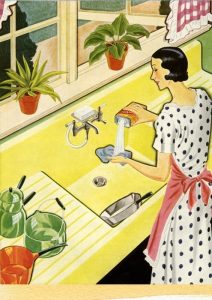 Around the same time, in our abundant spare time, my husband and I started going to used bookstores, antique markets and thrift stores. They were treasure troves of nostalgia and good tried and true advice. I started collecting old cookbooks from the mid-century era. Then I started collecting books about homemaking in the same years. I teased that I wanted to be a 1950’s housewife when I grew up. In reading about mid-century homemaking I soon realized that I could learn a thing or two from the mid-century housewives. After all, as stay at home housewives they were “professional homemakers”. They were also highly motivated to find ways and share ways to save money and time. Cleanliness, efficiency and frugality were very valued traits. Just read a mid-century magazine
Around the same time, in our abundant spare time, my husband and I started going to used bookstores, antique markets and thrift stores. They were treasure troves of nostalgia and good tried and true advice. I started collecting old cookbooks from the mid-century era. Then I started collecting books about homemaking in the same years. I teased that I wanted to be a 1950’s housewife when I grew up. In reading about mid-century homemaking I soon realized that I could learn a thing or two from the mid-century housewives. After all, as stay at home housewives they were “professional homemakers”. They were also highly motivated to find ways and share ways to save money and time. Cleanliness, efficiency and frugality were very valued traits. Just read a mid-century magazine
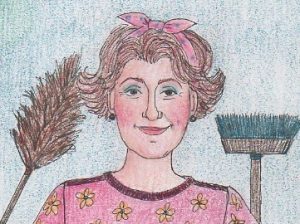 There were many, many books written to help the housewife with her homemaking skills. These books give advice on creating a pretty, organized, clean and efficient home. There is a lot of talk about being new, modern and scientific in your approach to making a house into a home. One of the things that strikes me as I read these books is the praise for new man made chemicals, that just feels wrong now. Plastics and vinyls are pushed as a housewife’s friend because when made into furniture, curtains, tablecloths, wallpaper or clothing they are said to be beautiful, sanitary and hard wearing, and therefore economical. No discussion about fabrics breaking down in the landfill or off gassing in the home. There is an exuberance about using new chemicals to solve household problems that makes me shiver. I am not even going to list their advice about using DDT, benzine, turpentine, carbon tetrachloride, gasoline, chloroform, or ether around the house.
There were many, many books written to help the housewife with her homemaking skills. These books give advice on creating a pretty, organized, clean and efficient home. There is a lot of talk about being new, modern and scientific in your approach to making a house into a home. One of the things that strikes me as I read these books is the praise for new man made chemicals, that just feels wrong now. Plastics and vinyls are pushed as a housewife’s friend because when made into furniture, curtains, tablecloths, wallpaper or clothing they are said to be beautiful, sanitary and hard wearing, and therefore economical. No discussion about fabrics breaking down in the landfill or off gassing in the home. There is an exuberance about using new chemicals to solve household problems that makes me shiver. I am not even going to list their advice about using DDT, benzine, turpentine, carbon tetrachloride, gasoline, chloroform, or ether around the house.
Aside from the toxic chemicals I have found most of the advice is very helpful. To put some order in your housekeeping, they suggest you have a well-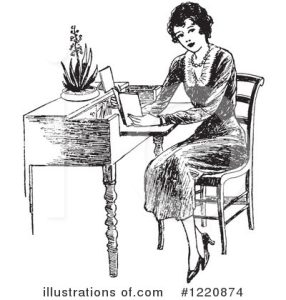 organized cleaning closet and that you regularly sit down and go over your cleaning checklist. You want to make sure the house is clean but you should not be exhausting yourself with “back breaking labour”. The recommendation is to have an easy daily and weekly chore list with a bigger list of deep cleaning chores for the fall and spring.
organized cleaning closet and that you regularly sit down and go over your cleaning checklist. You want to make sure the house is clean but you should not be exhausting yourself with “back breaking labour”. The recommendation is to have an easy daily and weekly chore list with a bigger list of deep cleaning chores for the fall and spring.
Every day, after breakfast and getting the various members of the family down for a nap, off to work or off to school, clear the table and get dishes soaking. Grab your basket of cleaning supplies and the vacuum cleaner. You should focus on the main living spaces in the house. Start by tidying and putting away clutter. Have need to have a place for everything to go out of sight. Look for any spills or messes to spot clean. If you see a need, using the vacuum cleaner start from the ceiling to the floor looking for cobwebs and dust. Next vacuum the furniture and floors. You may have to wet dust or use a soapy cloth to clean off sticky or greasy surfaces. You might need to wet mop some areas to finish. The kitchen and bathroom will need a quick clean too. Although you should be “cleaning as you go” to keep the kitchen sparkling all day long. Bedrooms, your husband’s study and less used areas only need to be cleaned weekly. These books also encourage the housewife to take breaks during the day, to sit down and read a magazine or sit to iron or sit at your desk to organize the shopping or menu planning. Life should not be all drudgery. Some very modern books even suggest getting the children involved in making beds, tidying rooms, setting and clearing the table and other chores appropriate to their age.
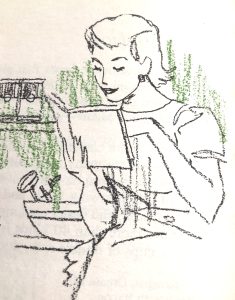 So a housewife had a daily and weekly cleaning routine and all kinds of modern chemicals in her cleaning closet, but the 1940’s housewife would be green with envy at the variety of cleaners I keep in my cleaning closet. Being able to spray and wipe messes would have been only a dream. Prior to World War II there were few ready to use all purpose cleaners on the market, and they were not always affordable or safe. Most cleaning was done with a mixture of one or more or soap, bleach, vinegar, ammonia and water. WARNING: Do not mix any of these together, bad gases happen.
So a housewife had a daily and weekly cleaning routine and all kinds of modern chemicals in her cleaning closet, but the 1940’s housewife would be green with envy at the variety of cleaners I keep in my cleaning closet. Being able to spray and wipe messes would have been only a dream. Prior to World War II there were few ready to use all purpose cleaners on the market, and they were not always affordable or safe. Most cleaning was done with a mixture of one or more or soap, bleach, vinegar, ammonia and water. WARNING: Do not mix any of these together, bad gases happen.
To truly appreciate how we got to the cleaners we have today it is good to see what came before. For centuries, even millennia (soap recipes have been found from 2800 BCE) we have used soap for cleaning ourselves and our stuff that was a variation on animal fat and lye. When mixed together animal fat and wood ash and water creates soap. It does a good job but in its simplest form. it is pretty rough on skin and fabric and leaves a film behind.
Over time we discovered plant oils and fragrance make lye soap better. Adding glycerin was an improvement too. The problem with bar soap is that it makes soap scum when it mixes with chemicals in hard water and some of the fat or dirt stays on the cleaned items. So it is not ideal for dishes or for clothes either. When laundry detergents came on the market it saved the housewife from the grind of mixing up the laundry soap mixture of washing soda, borax and soap shavings with warm water for every load. Many of these books sang the praises of detergent for washing, saying detergent dissolved easily in water and got the clothes cleaner.
Detergent for dishes was also a great invention because grease and dirt on the surface dissolved and lifted off leaving the dishes to dry spotlessly clean. Not having to dry dishes with a cloth was a time saver. Just think how excited your grandmother or great grandmother would have been when she heard the first squeaky clean dish in her bright yellow dish washing gloved hand. Truly the sound of clean.
And detergents would have replaced a lot of scrubbing and rinsing and bleaching all around the house as well. Getting surfaces of things like sinks and showers free of soap scum and clean and shiny quicker would have been a great time saver. Detergents may not have been a joy on linoleum as they may take off the carefully applied wax. Bleach and ammonia still had a place in the mid-century home but detergents were a game changer I am sure.
I must say as time goes on my cleaning closet is getting much less crowded with bottles. Inspired by earlier housekeepers I routinely use a simple mixture of one part water to one part vinegar a scant teaspoon of dishsoap in a spray bottle. My repurposed spray bottle holds 10 ounces total. This cleaner works on everything from mirrors to sinks to floors. And I have a bottle of concentrated Dawn dishsoap as well that I reach for on many cleaning and laundry tasks,
You may ask , how is my mid-century housekeeping routine coming along? Have I perfected the daily and weekly routines? It is still a work in progress, I am guilty to say.
